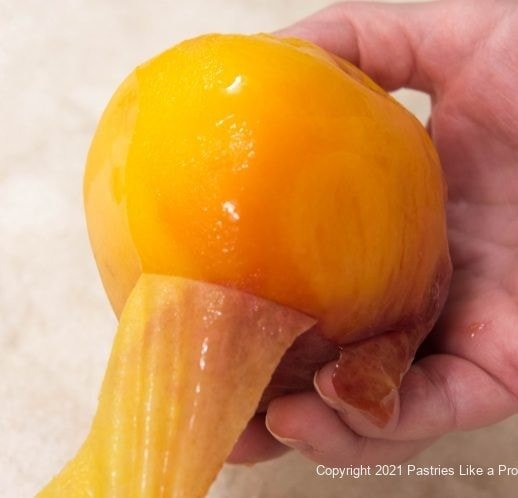
Peaches are one of, if not, my favorite fruits. I get excited when I see early Georgia Peaches in the market and I'm disappointed when I see the last of the local peaches leave. I haven't found a way I don't like them. Sweet or savory, baked or unbaked, folded into ice creams or just plain, they are my fruit of choice.
I wish markets would label the peaches as to their variety as they do apples. Red Havens are my favorite but unless I go to my local pick-your-own orchard, I can't find them. But the real culprit with peaches is what type they are - freestone or clingstone. I found this description from Allrecipes to be a good explanation of these two types.
"What Are Freestone Peaches?
What Are Freestone Peaches? Freestone or cling-free peaches refer to fruit where the flesh is not attached to the pit. When you cut or bite into these peaches, you can reach in and easily remove the pit, making them a pleasure to eat out of hand and great for cooking, baking, and canning, since they are easy to prep. Freestone peaches tend to show up later in the season, between mid-June and mid-August.What Are Clingstone Peaches?
What Are Clingstone Peaches? Clingstone peaches refer to peaches where the flesh is attached to the pit. These peaches are ideal for eating, but less desirable for cooking, baking, or canning projects since they are difficult to prep. Cutting the delicate flesh from the pit can bruise or damage it, leading to browning. Clingstone peaches are usually the first peaches available in the growing season, ripening between mid-May and early June.How I Peel My Peaches
There are two ways to get the skin off the peach. I use the one that is least damaging to the peach. Peeling the peaches can remove some of the flesh of the peach which is why I don't use this method.


My preferred method is to submerge them in boiling water for several minutes during which time the peel will loosen from the flesh. A quick dip in cold water and the peel comes right off leaving the peach in tact. The one caveat with this method to work is the peach must be ripe.
Removing the Pits or Stones


After peeling the peach, cut through the peach, top to bottom and open up. If the peaches are freestone, the pits can easily be removed. If not, I usually cut the pit or stone out. Otherwise, the peach can be almost destroyed trying to remove it by pulling it out.
There's even a recipe on Kitchn that shares what to do with those pits.

Another one that I am dying to try is from One Ash Homestead. It uses the peels and pits to make Peach Jelly.
How to Avoid Oxidizing or Browning
Peaches, like other fruits will oxidize or turn brown if left uncovered after peeling and slicing. Immediately after peeling and slicing, place plastic wrap directly on top and refrigerate. This usually works for a day or so.
What I like to do is use the boiling water method to skin the peaches, then immediately wrap each one tightly in plastic wrap and refrigerate. This keeps them from browning for several days.
Now after you've peeled the peaches, here's a few ideas for what to do with them!
Dutch Peach Pie
Peach Curd Tart
Peach Swirl No Churn Ice Cream
White Wine Peach Sauce








Eileen Murphy says
My only problem here is I love peaches and hubby not so much. Oh, well more for me or more to share with friends. Thank you Helen.
hfletcher says
Hi Eileen - I can't imagine anyone not being wild about peaches but my son is so-so on them. One time when he visited, I had made the Peach Swirl Ice Cream and he couldn't stop eating it. So much for so-so!
Eileen Murphy says
I checked out you peach crumb pie. Glad to see you used the same crumb topping that you used for the NY Style crumb cake. I have been using that for all my crumb toppings ever since I first tried the crumb cake. PS: My daughter and family are coming soon. Since it is both my birthday and my 3 year old grandson's birthday we decided to make the no churn chocolate ice cream for him and the peach curd tart for me.
hfletcher says
Sounds like a great birthday party! Lucky grandson.
Lynette Pruett says
Sorry, Helen...one quick question on the Peach Curd Tart recipe. I notice that in the instructions for the French Pate Sucre Crust instructions, you roll this crust into a round and fit it in the tart pan. I’ve used your hand pressing method for Tart crusts since I read it on your blog, and wonder if there is a reason that this particular crust should be rolled. I find the hand pressed method much easier!
hfletcher says
The Pate Sucre is a completely different crust. Just as an American Pie crust has to be rolled out, so does the pate sucre or the pate brisee. You can sub the press in but it isn't as delicate or buttery as the sucre. Also, I don't believe there is enough dough to press it in. It is very thin. Hope this helps.
Lynette Pruett says
Be still, my heart! PEACHES...how better to fill a summer menu! I followed your link to the Peach Curd Tart recipe, and see some peach curd on the horizon at our house, ready to top some scones soon! Since I enjoy scones so much, I’ve made curd with many different fruits over the years, but somehow it never occurred to me to use peaches!
Thanks so much for sharing your knowledge and experience with us.